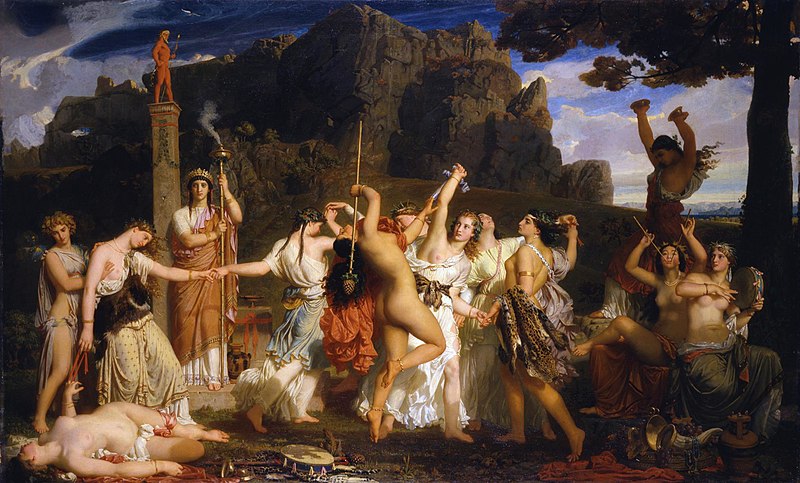File:Charles Gleyre La Danse des bacchantes.jpg

Original file (2,048 × 1,236 pixels, file size: 298 KB, MIME type: image/jpeg)
Captions
Captions
Summary[edit]
| The Dance of the Bacchantes
( |
||||||||||||||||||||||||
|---|---|---|---|---|---|---|---|---|---|---|---|---|---|---|---|---|---|---|---|---|---|---|---|---|
| Author |
creator QS:P170,Q452119 |
|||||||||||||||||||||||
| Title |
French: La Danse des bacchantes The Dance of the Bacchantes title QS:P1476,fr:"La Danse des bacchantes"
label QS:Lfr,"La Danse des bacchantes"
label QS:Len,"The Dance of the Bacchantes" |
|||||||||||||||||||||||
| Object type |
painting object_type QS:P31,Q3305213 |
|||||||||||||||||||||||
| Description |
The Dance of the Bacchantes, the last painting by Gleyre exhibited publicly in Paris (at the Salon of 1849), came as a surprise to enthusiasts of bacchanals, which had been a traditional subject since the days of Titian and Poussin. Bacchus, Silenus and the satyrs are all absent, and the painting is therefore neither mythological nor fabulous, but rather historical and religious. Gleyre paints a mysterious, wild and exclusively female ritual, captured in very precise draughtsmanship and a smooth technique producing what one critic calls the strange effect of a “choreography, which is both noble and unbridled, frenzied and rhythmic”. Following in the footsteps of A l'instar de Pentheus, The Dance reveals a new, popularised reading of the roots of ancient Greek civilisation and its forms of worship in the 1830s. Contrary to the solar, masculine and Apollonian vision which had been extolled by Winckelmann since the mid-18th century, Gleyre depicts the primitive, eastern and Dionysian Greece, posited in the works of the philologist and historian Friedrich Creuzer. Subjects drawn from Antiquity provided the painter with the opportunity for a personal and unusual meditation on the origins of the arts, omitting any reference to either Apollo or Orpheus. In The Dance invented by the Bacchantes, the music played to animals in Minerva, the art of spinning taught to an absurd Hercules by the beautiful Omphale, and the love poetry composed by Sappho - the secret of the arts seems to be the preserve of women, acquired through a mysterious and intuitive affinity with the divine powers of creation. |
|||||||||||||||||||||||
| Date |
1849 date QS:P571,+1849-00-00T00:00:00Z/9 |
|||||||||||||||||||||||
| Medium |
oil on canvas medium QS:P186,Q296955;P186,Q12321255,P518,Q861259 |
|||||||||||||||||||||||
| Dimensions |
height: 147 cm (57.8 in); width: 243 cm (95.6 in) dimensions QS:P2048,147U174728 dimensions QS:P2049,243U174728 |
|||||||||||||||||||||||
| Collection |
institution QS:P195,Q3329523 |
|||||||||||||||||||||||
| Accession number |
1995-093 |
|||||||||||||||||||||||
| Credit line |
Français : Acquisition avec un crédit extraordinaire de l’État de Vaud et la participation de Fondation Gottfried Keller, Gonset Holding S.A., Fondation Ernst Göhner, Association des Amis du musée, ATAG Ernst & Young, 1995 |
|||||||||||||||||||||||
| Notes |
Français : Musée cantonal des Beaux-Arts enligne |
|||||||||||||||||||||||
| References | Charles Gleyre (1806-1874). The reformed Romantic 9. Musée d'Orsay (2016). Retrieved on October 13, 2017. | |||||||||||||||||||||||
| Source/Photographer | https://underpaintings.com/whats-on-view/charles-gleyre-the-reformed-romantic/ | |||||||||||||||||||||||
Licensing[edit]
|
This is a faithful photographic reproduction of a two-dimensional, public domain work of art. The work of art itself is in the public domain for the following reason:
The official position taken by the Wikimedia Foundation is that "faithful reproductions of two-dimensional public domain works of art are public domain".
This photographic reproduction is therefore also considered to be in the public domain in the United States. In other jurisdictions, re-use of this content may be restricted; see Reuse of PD-Art photographs for details. | |||||
File history
Click on a date/time to view the file as it appeared at that time.
| Date/Time | Thumbnail | Dimensions | User | Comment | |
|---|---|---|---|---|---|
| current | 13:59, 13 October 2017 |  | 2,048 × 1,236 (298 KB) | Mabrndt (talk | contribs) | User created page with UploadWizard |
You cannot overwrite this file.
File usage on Commons
The following page uses this file:
File usage on other wikis
The following other wikis use this file:
- Usage on da.wikipedia.org
- Usage on de.wikipedia.org
- Usage on en.wikipedia.org
- Usage on eu.wikipedia.org
- Usage on he.wikipedia.org
- Usage on nl.wikipedia.org
- Usage on ru.wikipedia.org
- Usage on sv.wikipedia.org
Metadata
This file contains additional information such as Exif metadata which may have been added by the digital camera, scanner, or software program used to create or digitize it. If the file has been modified from its original state, some details such as the timestamp may not fully reflect those of the original file. The timestamp is only as accurate as the clock in the camera, and it may be completely wrong.
| Copyright holder | JC Ducret, Musée des Beaux-Arts, Lausanne |
|---|---|
| Original transmission location code | Ha_kqQH456tEA6_gHZge |

